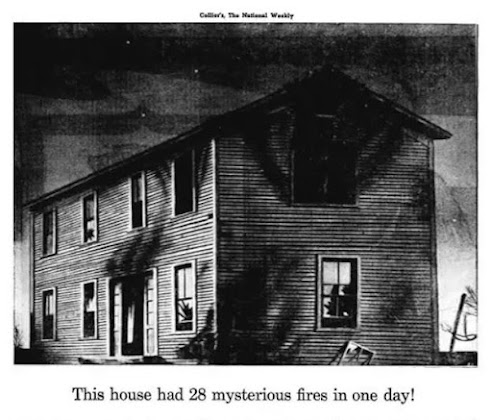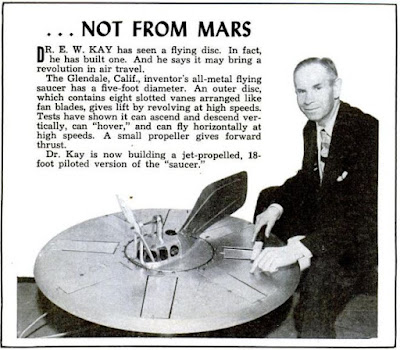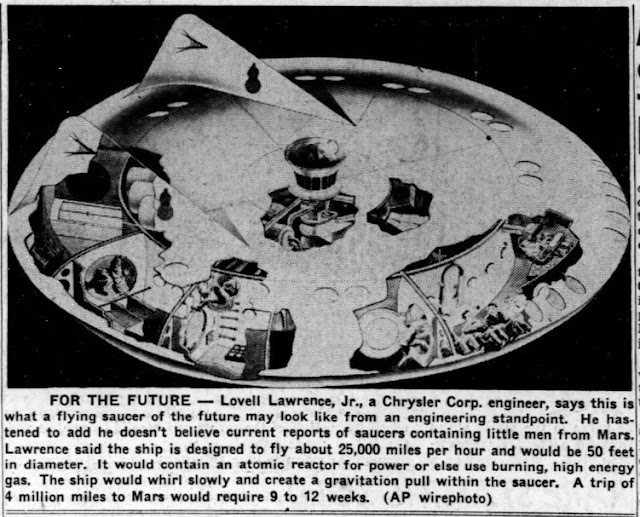Alexander Sarantos Tremulis (1914-1991) started his 45-year tenure as an industrial designer in the automotive industry in 1933, where he worked for renowned companies such as General Motors, Tucker, Kaiser-Frazer, and Ford. However, Tremulis' career took a detour in 1941 when he joined the U.S. Army Air Force at Wright Field in Dayton, Ohio during World War II. At Wright Field, he utilized his design skills to aid in aircraft development and refined his sleek aerodynamic designs by testing his models in wind tunnels.
After the war, he returned to automobile design, and brought some of the same principles forward, striking aerodynamic forms for the roadways.
However, our focus here is on the early flying saucer era and how Tremulis was part of it. The Dec. 1983 Road & Track magazine featured a retrospective of Tremulis’ career:
“While he was at Wright Field, Alex made the first drawings of a proposed flying saucer, and it resulted in considerable consternation. A rumor started to the effect that a flying saucer had crashed in Mexico and two bodies measuring 29 in. had been removed from the wreckage and taken to Wright Field. This was nonsense, but it started all the flying saucer interest that has lasted to this day.”
Tremulis became involved in the UFO topic before any of the books about flying saucers were published, and the closest thing to magazine on the subject was Fate from Ray Palmer. Until Frank Scully published Silas Newton’s hoaxed Aztec flying saucer crash story in late 1949, there wasn’t much talk about saucer occupants or depictions of them in them outside of science fiction. However, when the news of "little men" from Venus surfaced, it received significant media attention, and Tremulis, like many others, believed there was some truth to the story. The saucer men in the Aztec story were just miniature humans, but Tremulis imagined the occupants would have to be far more alien. He put some thought into it and made illustrations of what a spaceship and first contact with the race who flew them would look like. He wrote the article, “Maybe We Are Being Shot At – Who Knows?” (reprinted at the Gyronaut X-1 site).
Tremulis started the article by mentioning that on March 9, 1950, he heard a radio broadcast about a saucer crash landing and a midget pilot. He also showed familiarity with early UFO events, such as those chronicled by Charles Fort.
“I, for one, have never been of the opinion that we earthlings enjoyed a monopoly of all the brains in the solar system. Many strange happenings dating back as far as 1870 have not been thoroughly explained to my satisfaction.
… From the fragmentary evidence that I have at my disposal, mainly reports in the newspapers, I have attempted to sketch my conception of such a space vehicle. … In my opinion, there is nothing wrong about the configuration of a so called disk that does not apply to good aerodynamic law. ... The propulsion units must no doubt be of a highly developed form of nuclear energy in order to have the apparently limitless range of millions of miles.”
His sleek disc had a thin body propelled by rocket thrusters. In the center of the disc, an alien pilot sat at the controls in a dome with an antenna on top.
As for the saucer’s occupants, he speculated:
“Perhaps these strangers at the moment on their reconnaissance flight are afraid of us and are reluctant to land. … They no doubt at our first meeting will have facilities in the way of unique instruments where our first words will be instantly decode into their language.”
His illustration showed two human men, perhaps a scientist and Air Force officer seated at a large table. On it stood two small humanoids, distinctly alien figures, one wearing a device on his head, part of the translation machine the other helped operate. From the machine produced something like a ticker tape for the humans to read. Joel Carpenter had this to say about Tremuilis’ pioneering illustration of aliens:
“The facial features of the ETs are extremely intriguing. To modern eyes, they look exactly like the ‘standard Grey alien’ described in recent abduction literature, with their large heads and wraparound eyes. Their boot-belt-and-tunic outfits are dated and science-fiction-clichéd, but the overall impression is rather arresting.”
Tremulis submitted his saucer artwork to The Chicago Tribune. It was published and syndicated to papers across the U.S. in March of 1950.
Kaiser-Frazer featured his spaceship concepts in K-F News, June 23, 1950, with further details about Tremulis’ thoughts on the saucers and the little men. “[T]he reason many people figure the disks are piloted by small men, he says, is because normal size human beings could not withstand the strain of such violent maneuvers as the discs reportedly go through.” As for his saucer design, he said it was more than a fantasy:
“The flying disc which he sketched from the witnesses’ description is capable of flight. In fact, he says he could make a scale model of it that would fly. The tapered surfaces are not unlike those of some of our latest jet aircraft and the saucer shape would make hovering in a stationary position possible.”
Tremulis’ art was featured in not only in newspapers, but reprinted in magazines, and in The Coming of the Saucers by Kenneth Arnold and Raymond Palmer, 1952, on page 187.
Flying Saucers for Automobiles
On January 27, 1951, Tremulis filed a design patent application for an automobile hood ornament based on his flying saucer illustration. It was granted on Sept. 4, 1951, to Alexander S. Tremulis, and to Peter S. Pagratis & Associates.
The body of the saucer was chrome, the dome was either yellow, green, or blue, lit by an electric light bulb. The product was a hit and sold well for about two years. Fortune Manufacturing sold about 4,000 of the saucer ornaments, before ceasing operations, 146,000 short of the goal. The site, Automobilia: “It Came From... Alex Tremulis?” features the story from his partner about how their saucer product came to be - and how it all came to an end.
In 1950, Peter S. Pagratis was “a struggling engineering student at the Illinois Institute of technology,” new to the automobile hood ornament business. He set out to design one to capitalize on the flying saucer fever but was having trouble.
“One day however, there was a full page rendering of Alex Tremulis' flying saucer in the Chicago Sun Times. … I phoned Alex and said: ‘if you want to be a 50%-50% partners, I will have your Flying Saucer design made into an automobile hood ornament.’ We became partners and I sold the design on a cash & royalty basis to Fortune Mfg. Co. in Chicago, who were thrilled with the design.
The Flying Saucer hood ornament became such a huge hit, the Mfg. put on a second shift to keep up with sales demand. Things were looking great when I received a distressed phone call from the Mfg. owner lamenting ‘We are out of Business!’ The Korean War had just started and the US Gov. just allocated Chrome and Zinc to the war effort (the principle components of hood ornaments). What a let down that was for us all! It was such an unexpected and abrupt end to Flying Saucer Hood Ornaments.”
You Can Take the Boy out of the Saucer…
In 1952 Tremulis had left Kaiser-Frazer and was designing futuristic show cars for Ford, For Christmas, he added hieroglyphics to the bottom of his alien drawing and translated the ticker tape for us:
“All Space Beings Send Xmas Greetings To All Ford Employees. [signed] Gort.”
The front page of The Des Moines Register, October 11, 1953, featured an excerpt from by Donald Keyhoe’s book, Flying Saucers From Outer Space. The illustration to accompany it? Tremulis’ flying saucer.
In the UK, his artwork was among the material under examination by the British Flying Saucer Bureau.
 |
| The Bristol Evening Post, Nov. 20, 1953 |
Columnist Inez Robb’s Oct. 18, 1956, article said the Ford Motor Co. had not built a flying saucer yet, but they had a “Buck Rogers division” and its “chief ‘space man,’ dreamer and Buck Rogers” was Alex Tremulis, who was developing “Nucleon, the projected atom car.”
There’s a passage on flying saucers from the 20011 book, by Arvid Linde, Preston Tucker and Others: Tales of Brilliant Automotive Innovators and Innovations. We were unable to find anything to confirm it but did find supporting evidence that proves Alex Tremulis worked with models in his career, owned a camera, and had a sense of humor.
“Tremulis was a bit of a jester, and enthusiastic ufologist, too. ... It is rumored that a certain amount of UFO photographs that were ‘leaked’ to the press, were actually the creative work of cheeky Alex Tremulis. He often authored photo-collages that depicted UFOs over popular places in America. It is just possible that Tremulis is one of those responsible for the UFO-mania of the 1950s, and the hobby ufologist who still keep old newspaper cuttings with information about odd flying objects are simply naive victims of the fun-loving Tremulis.”
After the hood ornament venture, Tremulis was out of the flying saucer business. Nevertheless, he had permanent influence on the way we visualize UFOs and aliens. Some people have speculated that his space disc design inspired that of the starship Enterprise from Star Trek. Whatever the case, Tremulis continued to design futuristic vehicles that looked like they could have come from outer space.
 |
| Ford Gyron (1961) |
Tremulis died December 29, 1991, at the age of 77. His impact on the perception of UFOs as being structured spacecraft from other worlds has been under-appreciated. However, when he was honored in a tribute by the Society of Automotive Engineers (SAE), freelance writer Deke Houlgate asked:
"Do we have Alex Tremulis to thank for 40 years of speculation over space visitors?"
. . .
For Further Reading
Alexander Sarantos Tremulis (1914-1991) Obituary - Bio
Alex Tremulis Automotive Hall of Fame Induction Video
Joel Carpenter’s site, UFX: Archetypal Engineering: Alex Tremulis: Saucer Designer
Gyronaut X-1 site: Alex Tremulis' Flying Saucer: Catalyst for the 1950's UFO Craze


















.png)
























.png)

























